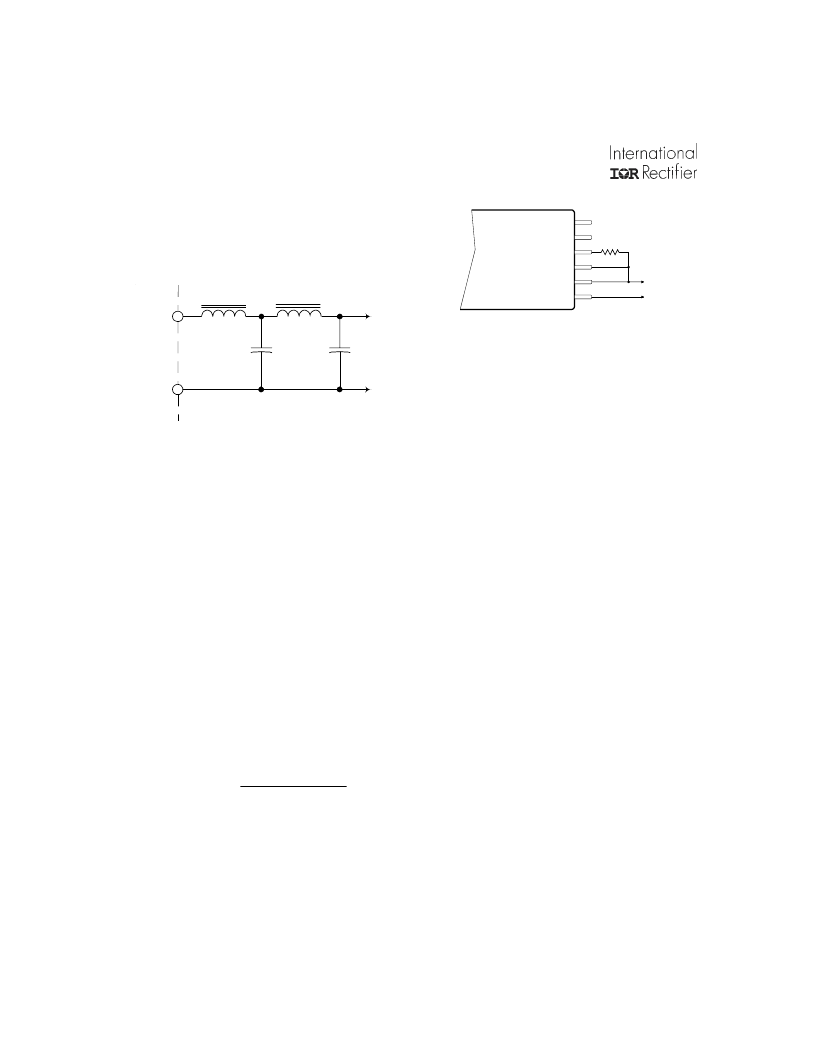- 您現(xiàn)在的位置:買賣IC網(wǎng) > PDF目錄362157 > AFL2808SW DC to DC Converter PDF資料下載
參數(shù)資料
| 型號(hào): | AFL2808SW |
| 英文描述: | DC to DC Converter |
| 中文描述: | DC至DC轉(zhuǎn)換器 |
| 文件頁(yè)數(shù): | 8/11頁(yè) |
| 文件大小: | 115K |
| 代理商: | AFL2808SW |

8
www.irf.com
AFL28XXS Series
General Application Information
The AFL28XXS series of converters are capable of pro-
viding large transient currents to user loads on demand.
Because the nominal input voltage range in this series is
relatively low, the resulting input current demands will be
correspondingly large. It is important therefore, that the line
impedance be kept very low to prevent steady state and
transient input currents from degrading the supply voltage
between the voltage source and the converter input. In
applications requiring high static currents and large tran-
sients, it is recommended that the input leads be made of
adequate size to minimize resistive losses, and that a good
quality capacitor of approximately100
μ
fd be connected di-
rectly across the input terminals to assure an adequately
low impedance at the input terminals. Table I relates nomi-
nal resistance values and selected wire sizes.
Input Filter
Undervoltage Lockout
The AFL28XXS series converters incorporate a two stage
LC input filter whose elements dominate the input load im-
pedance characteristic during the turn-on. The input circuit
is as shown in Figure IV.
Figure IV. Input Filter Circuit
A minimum voltage is required at the input of the converter
to initiate operation. This voltage is set to 14.0
±
0.5 volts. To
preclude the possibility of noise or other variations at the
input falsely initiating and halting converter operation, a hys-
teresis of approximately 1.0 volts is incorporated in this
circuit. Thus if the input voltage droops to 13.0
±
0.5 volts,
the converter will shut down and remain inoperative until the
input voltage returns to
≈
14.0 volts.
Output Voltage Adjust
Pin 1
Pin 2
900nH
130nH
6 μfd
11.2 μfd
In addition to permitting close voltage regulation of remotely
located loads, it is possible to utilize the converter sense
pins to incrementally increase the output voltage over a
limited range. The adjustments made possible by this method
are intended as a means to “trim” the output to a voltage
setting for some particular application, but are not intended
to create an adjustable output converter. These output volt-
age setting variations are obtained by connecting an appro-
priate resistor value between the +sense and -sense pins
while connecting the -sense pin to the output return pin as
shown in Figure V. below. The range of adjustment and
corresponding range of resistance values can be deter-
mined by use of the following equation.
R
= 100
adj
-
-.025
NOM
V
V
OUT
V
NOM
Where
V
NOM
= device nominal output voltage, and
V
OUT
= desired output voltage
Figure V. Connection for V
OUT
Adjustment
Finding a resistor value for a particular output voltage, is
simply a matter of substituting the desired output voltage
and the nominal device voltage into the equation and solv-
ing for the corresponding resistor value.
Enable 2
Share
+ Sense
- Sense
Return
+ V
out
To Load
R
ADJ
AFL28xxS
Note: R
adj
must be set
≥
500
Attempts to adjust the output voltage to a value greater than
120% of nominal should be avoided because of the poten-
tial of exceeding internal component stress ratings and sub-
sequent operation to failure. Under no circumstance should
the external setting resistor be made less than 500
.
By
remaining within this specified range of values, completely
safe operation fully within normal component derating limits
is assured.
Examination of the equation relating output voltage and re-
sistor value reveals a special benefit of the circuit topology
utilized for remote sensing of output voltage in the AFL28XXS
series of converters. It is apparent that as the resistance
increases, the output voltage approaches the nominal set
value of the device. In fact the calculated limiting value of
output voltage as the adjusting resistor becomes very large
is
≈
25mV above nominal device voltage.
The consequence is that if the +sense connection is unin-
tentionally broken, an AFL28XXS has a fail-safe output volt-
age of Vout + 25mV, where the 25mV is independent of the
nominal output voltage. It can be further demonstrated that
in the event of both the + and - sense connections being
broken, the output will be limited to Vout + 440mV. This 440
mV is also essentially constant independent of the nominal
output voltage.
相關(guān)PDF資料 |
PDF描述 |
|---|---|
| AFL2828S | Hi-Rel DC-DC Standard Single Converter in a AFL package |
| AFL2828SZ | DC to DC Converter |
| AFL2812SZ | DC to DC Converter |
| AFL2815D | Hi-Rel DC-DC Standard Dual Converter in a AFL package |
| AG-40 | GLAND M40 22-32MM |
相關(guān)代理商/技術(shù)參數(shù) |
參數(shù)描述 |
|---|---|
| AFL2808SW/CH | 制造商:International Rectifier 功能描述:DC/DC CONVERTER, CLASS H - Bulk |
| AFL2808SW/ES | 制造商:International Rectifier 功能描述:DC/DC CONVERTER, ENVIRONMENTAL SCREENING - Bulk |
| AFL2808SW/HB | 制造商:International Rectifier 功能描述:DC/DC CONVERTER, CLASS H EQUIVALENT, NO ELEM EVAL - Bulk |
| AFL2808SW-CH | 制造商:IRF 制造商全稱:International Rectifier 功能描述:ADVANCED ANALOG HIGH RELIABILITY HYBRID DC/DC CONVERTERS |
| AFL2808SW-ES | 制造商:IRF 制造商全稱:International Rectifier 功能描述:ADVANCED ANALOG HIGH RELIABILITY HYBRID DC/DC CONVERTERS |
發(fā)布緊急采購(gòu),3分鐘左右您將得到回復(fù)。